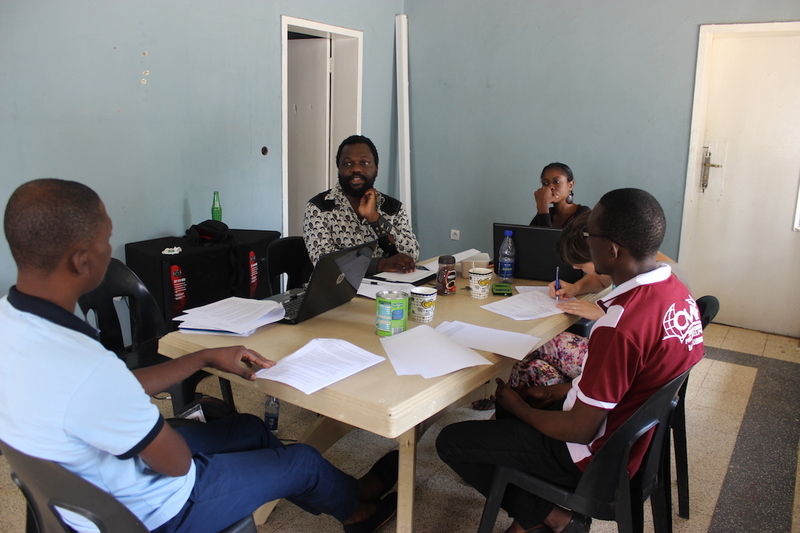The history of visual art education in and around the city of Lubumbashi in the Democratic Republic of Congo has been much analysed in relation to the ‘Indigenous Art Workshop’ known as “Le Hangar”, which operated there in the years 1ti46-1ti54. This school, sometimes described as «the first art school in francophone Africa», is considered by many to be the first expression of modern art by Congolese artists. Taking this school as the starting point and considering, in particular, the medium of easel painting, has often resulted in the creation of linear narratives linking the students of Le Hangar workshop Pilipili Mulongoy, Bela Sara and Mwenze Kibwanga, directly to the creation of the Academy of Fine Arts in Lubumbashi in 1952, with artists such as Mode Muntu and François Amisi, and also with autodidact painters such as Kanyemba, right up to the generation of young artists currently practising today, such as Trésor Malaya.
This hegemonic narrative has two main problematic features: it focuses on the formal institutions, thus ignoring the existence of other contemporaneous contexts of learning and exchange; and it consistently frames successive Western mentors as the sole engines or catalysts of creative dynamic. Artistic creation is presented as a process whereby institutions created and supported by western mentors create the discourse and where the Congolese artists are merely «awakened» by interventions of outsiders. Such narratives also maintains the idea that art, in its so called «modern» or «contemporary» form, is a Western or even (neo)colonial import, and that the only way to appreciate it and give it value is by reading it through the canons of western culture.
1
But this narrative’s omissions are interesting and important for us as arts and cultural producers in Lubumbashi explore:
- What happened «just before» the arrival of the white men?
- To what extent are the successive generations of ‘discovered’ Congolese artists extracted from their ‘ecosystem’ through that process, or is their significance embedded in the context that produced them?
- What practices and which artists have received limited a?ention from the cultural gatekeepers?
- In which ways were the ‘discovered’ artists’ practices reinvented or manipulated by their western mentors?
- And above all, how did other intellectuals and social contexts in Congo react to and engage with this artistic profusion?
The Lubumbashi Working Group (LWG) aims to question the silences of this history and reveal the sometimes perverse features hidden in the choice of event and in partial narratives. Our approach is not to deny the contributions and exchanges that built the artistic practices in the Congo since the 1tith century, but precisely to make visible and to explore the participation and agency of the Congolese artistic community and to demonstrate that, as Senghor puts it, in these “encounters” there is both “giving” and “receiving». Our desire is to challenge the stereotype of a technical performance by Congolese artists that is and legitimised by a Western aesthetic and intellectual expertise, and to value and to nurture the critical work of Congolese art historians and other specialists. The project aims finally to bring to light and, where necessary to develop other frameworks of discussions, exchanges, knowledge sharing and expertise that are not necessarily at play within Lubumbahi’s arts and cultural institutions at this time.
We propose to begin this research by investigating what occurred in our city in the 1ti70s, in particular at the School of Humanities of the University of Lubumbashi – a period that is ouen overlooked but which we consider to be pivotal: After the student protests of 1968 and 1969, the University of Kinshasa was closed and the Mobutu regime enacted wholesale reform of university education in order to suppress any challenge to his authority while at the same time implementing a cultural policy based on Senghor’s the concept of cultural»authenticity».
In the early 1ti70s, the universities were wholly centralised into the Official University of the Congo, and its faculties dispersed among three extremely disparate campuses: Kinshasa, Lubumbashi, Kisangani. The humanities faculty, that the regime considered potentially subversive, was located as far from the capital as possible in the city of Lubumbashi. Thus the city, during what came to be known as ‘the school of humanities of Lubumbashi’ then became home to a high concentration of notable Congolese and foreign intellectuals, including Johannes Fabian, VY Mudimbe, George Ngal, Allen Roberts, Bugumil Jewsiewicki. Our research into this period questions the place of the African intellectual in the world, effects and the legacy of European colonization, the evolving discourse on concepts of modernity within the context of a repressive dictatorial political regime. These are topics which were discussed extensively at the university at the time, but which percolated into the city, even into the “cité” (popular working-class neighbourhoods), spread through the students, and the youngest of them all still listening with one ear.
The LWG intends to explore the extent to which this period was a turning point in the transition between an arts education based mostly on a technical skills-based approach, and the more complex, more discursive modes of artistic production that reflected post-1ti68 modernity and post-colonial relations. The project “Replay the 1ti70” (read «replay mille neuf cent septante» in English and Belgian French) is inspired by the French title of the article in English VY Mudimbe “
Reprendre
”, which calls for a resumption of the analysis on the concept of art but also a re-appropriation of this discourse. Today, when these discussions are largely conducted in English in foreign universities to which the University of Lubumbashi and the society of Lubumbashi are tenuously connected (if at all), how can we reconsider this link to the world that emerged in Lubumbashi in the 1ti70s? What can this period tell us about the transfer of knowledge? How do «contemporary» artists of Lubumbashi connect to this intellectual production that inspired many artists around the world?

